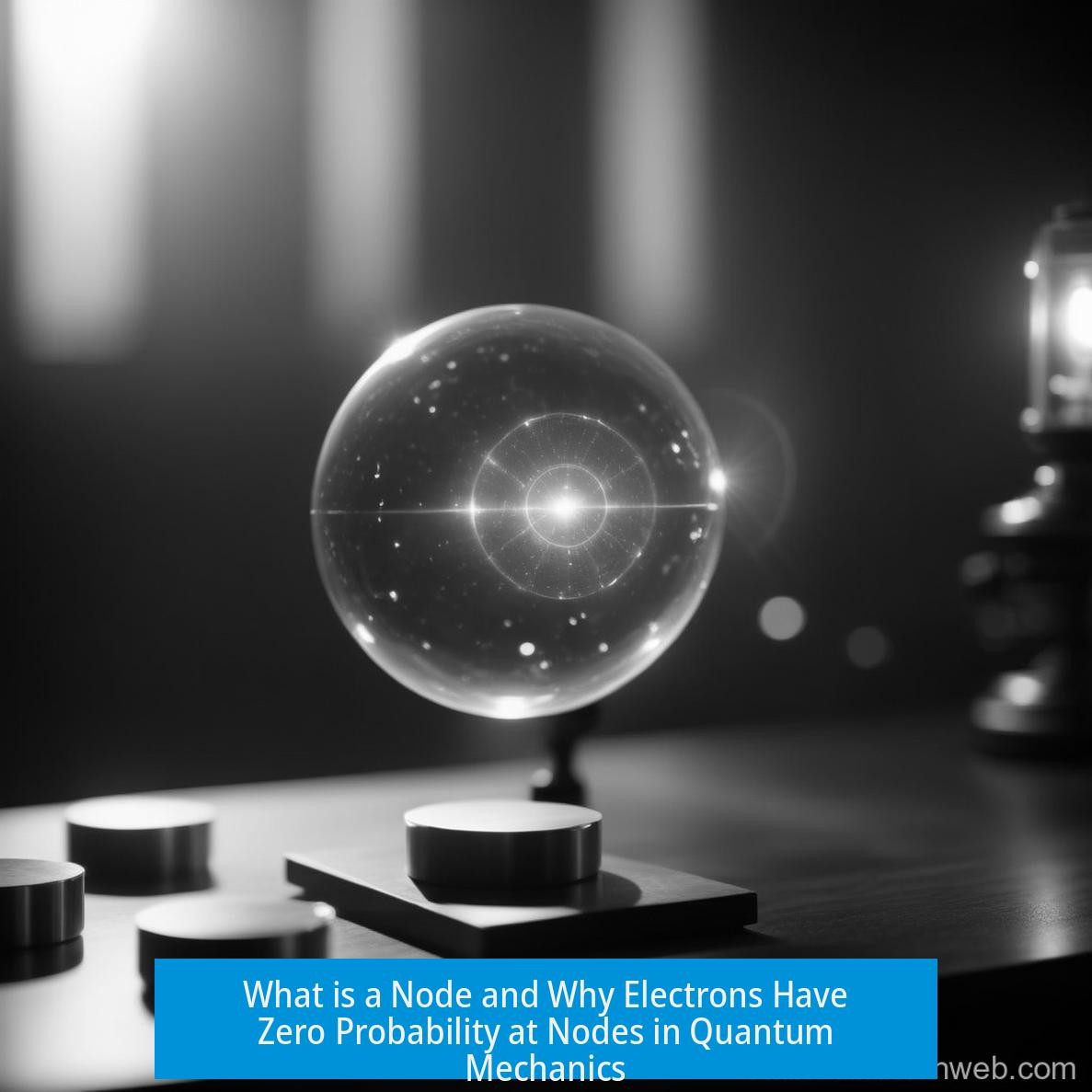What Is a Node and Why Is There a Zero Probability of Finding an Electron at a Node?
A node is a region around an atom’s nucleus where the electron’s wavefunction equals zero, leading to zero probability of finding the electron in that location. This zero probability arises because the probability of locating an electron is given by the square of the wavefunction’s magnitude, which equals zero at a node.
Understanding the Concept of a Node
In quantum mechanics, electrons do not have precise positions but exist in probabilistic regions called orbitals. These orbitals are described by wavefunctions, mathematical functions derived by solving the Schrödinger equation. The wavefunction, denoted usually by Ψ, encodes information about where an electron is likely to be found.
A node is any location where the wavefunction value is exactly zero. Since the probability of finding an electron is proportional to |Ψ|2, when Ψ = 0, the probability density is also zero. This means an electron cannot be detected at a node. Nodes are sometimes called “dead spaces” within an orbital because the electron simply does not reside there.
Wavefunction and Electron Probability
The wavefunction Ψ(x,y,z) represents the quantum state of the electron. The electron’s measurable presence aligns with |Ψ|2, the square of the wavefunction’s amplitude, which serves as a probability density function. Experimental position measurements link directly to these probability values.
When Ψ equals zero at certain points or surfaces, the corresponding probability density vanishes. These zero-probability points or regions are the nodes. Thus, the presence of nodes is a fundamental result of the wavefunction’s nature.
Types of Nodes: Radial and Angular
Nodes occur in different forms, depending on the shape and energy level of the orbital:
- Radial Nodes: These are spherical surfaces where the wavefunction crosses zero as a function of distance from the nucleus. Radial nodes exist in all orbitals except the 1s, increasing with the principal quantum number. For example, in the 2s orbital, one radial node exists between the nucleus and the outer region.
- Angular Nodes: These nodes are planes or cones where the wavefunction changes sign and passes through zero, related to the orbital’s angular part. In p orbitals, angular nodes appear as planar nodes dividing the lobes of the dumbbell-shaped wavefunction. The number of angular nodes equals the azimuthal quantum number (l).
The total number of nodes in an orbital equals n – 1, where n is the principal quantum number. This count includes both radial and angular nodes.
Physical Interpretation of Nodes and Electron Probability
An orbital should be thought of as a probability cloud where electrons have higher or lower chances of being found. Nodes represent boundaries inside this cloud where the probability dips to zero.
Consider the p orbital’s two lobes. The node lies between them, forming a plane where no electron is found. This occurs because the wavefunction changes sign across the node, indicating a phase difference. The node is the boundary of destructive interference between these phases.
Mathematical Origin: Schrödinger Equation and Boundary Conditions
Nodes arise naturally when solving the Schrödinger equation—a partial differential equation governing electron behavior in an atom. The boundary conditions applied to this equation cause the wavefunction solution to be zero at certain points or surfaces.
For example, in a simple “particle in a box” model, nodes appear at fixed boundaries and internal positions due to standing wave patterns. Similarly, atomic orbitals exhibit nodes fashioned by the electron’s wave-like nature and interactions with the electrostatic field of the nucleus.
Where the wavefunction’s waves interfere destructively, the amplitude must be zero, creating nodes. Physically, this means the electron cannot occupy these points because the quantum mechanical probability distribution nullifies there.
Quantum Mechanical Context and Electron Localization
Quantum mechanics treats electrons as wave-particles lacking classical trajectories. They do not move along well-defined paths but exist as probability distributions with dynamic behavior.
Electrons “jump” between orbitals rather than smoothly transition, making their instantaneous position undefined outside measurement. Nodes correspond to consistent zero positions in these probability distributions based on orbital shape and energy.
Experimental Evidence Supporting Nodes
Though nodes stem from mathematical quantum theory, advanced experimental tools provide indirect confirmation.
Techniques like atomic force microscopy (AFM) and scanning tunneling microscopy have imaged electron density on surfaces, showing patterns that align closely with predicted probability distributions featuring nodes. While direct visualization of nodes remains difficult, experimental observations support the accuracy of models that predict their existence.
Summary: Key Points on Nodes and Electron Probability
- A node is a region where the electron’s wavefunction equals zero, causing zero probability of finding the electron there.
- The probability of locating an electron is the square of the wavefunction’s magnitude, thus zero wavefunction implies zero probability.
- There are two types of nodes: radial nodes (spherical shells) and angular nodes (planes or cones).\
- Nodes are mathematically necessary results from solving the Schrödinger equation with boundary conditions and wave interference.
- Electrons behave as quantum waves with probability distributions, and nodes correspond to zero-probability zones in these distributions.
- Experimental microscopy techniques provide evidence supporting these theoretical predictions of nodes.
Understanding nodes improves comprehension of atomic structure, chemical bonding, and electron behavior fundamental to chemistry and physics.
What is a node in the context of an electron’s wavefunction?
A node is a point or region where the wavefunction equals zero. At this spot, the probability of finding an electron is zero because probability depends on the square of the wavefunction’s magnitude.
Why is there zero probability of finding an electron at a node?
The electron’s probability is given by the square of the wavefunction’s value. Since the wavefunction at a node is zero, squaring it also gives zero. Therefore, no electron can be detected at the node location.
What types of nodes exist in atomic orbitals?
There are two main types: radial nodes and angular nodes. Radial nodes occur in s orbitals as spherical shells. Angular nodes appear as planes in p orbitals, causing distinct shapes like dumbbells.
How do nodes arise mathematically in quantum mechanics?
Nodes come from solving the Schrödinger equation. The boundary conditions and wave nature of electrons cause wavefunctions to cancel out at certain points, creating nodes through destructive interference.
Is there experimental evidence supporting the existence of nodes?
Advanced microscopy techniques, like atomic force microscopy, have shown electron density patterns matching theoretical models. Although nodes themselves aren’t always directly visible, the evidence supports their existence.





Leave a Comment